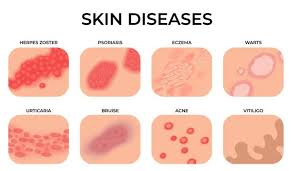
Skin rashes are a common dermatological issue affecting people of all ages. They can appear as red, itchy, inflamed, or scaly patches on the skin. Understanding the most common types of Skin Rashes and their treatments can help in managing symptoms effectively and seeking timely medical intervention. This guide explores various types of rashes, their causes, symptoms, and best treatment options.
1. Eczema (Atopic Dermatitis)
Symptoms:
-
Dry, itchy, and inflamed skin
-
Red or brownish patches
-
Cracked or scaly skin
-
Oozing or crusting in severe cases
Causes:
-
Genetic predisposition
-
Allergens and irritants
-
Climate and environmental factors
Treatment:
-
Moisturizers and emollients to hydrate the skin
-
Topical corticosteroids to reduce inflammation
-
Antihistamines to relieve itching
-
Avoiding allergens and irritants
2. Contact Dermatitis
Symptoms:
-
Red, itchy rash
-
Blisters or dry, scaly skin
-
Burning or stinging sensation
Causes:
-
Irritants (soaps, detergents, chemicals)
-
Allergic reactions (poison ivy, nickel, latex)
Treatment:
-
Identifying and avoiding the trigger
-
Applying hydrocortisone creams
-
Using antihistamines for allergic reactions
-
Cold compresses to soothe irritation
3. Psoriasis
Symptoms:
-
Thick, silvery, scaly patches on the skin
-
Red, inflamed areas
-
Itchy or painful lesions
Causes:
-
Immune system dysfunction
-
Genetic factors
-
Triggers like stress, infections, and certain medications
Treatment:
-
Topical treatments (steroids, vitamin D analogs)
-
Phototherapy (light therapy)
-
Systemic medications for severe cases
-
Lifestyle modifications like stress management
4. Hives (Urticaria)
Symptoms:
-
Raised, red, itchy welts
-
Swelling in some cases
-
Symptoms that appear and disappear suddenly
Causes:
-
Allergic reactions (foods, medications, insect bites)
-
Infections
-
Temperature changes
-
Stress
Treatment:
-
Antihistamines to reduce itching and swelling
-
Avoiding allergens and triggers
-
Cold compresses for relief
-
Epinephrine for severe allergic reactions
5. Ringworm (Tinea Corporis)
Symptoms:
-
Circular, red, scaly patches with a defined border
-
Itching and discomfort
-
Spread over different body parts
Causes:
-
Fungal infection
-
Skin-to-skin contact or contaminated surfaces
-
Warm, humid environments
Treatment:
-
Antifungal creams and ointments
-
Oral antifungal medications for severe cases
-
Maintaining proper hygiene
6. Shingles (Herpes Zoster)
Symptoms:
-
Painful rash with fluid-filled blisters
-
Burning or tingling sensation
-
Fever and fatigue
Causes:
-
Reactivation of the varicella-zoster virus (chickenpox virus)
Treatment:
-
Antiviral medications (acyclovir, valacyclovir)
-
Pain relievers
-
Cool compresses for relief
-
Vaccination to prevent shingles
7. Rosacea
Symptoms:
-
Facial redness and visible blood vessels
-
Swelling and pimples
-
Eye irritation in some cases
Causes:
-
Genetic and environmental factors
-
Triggers like sun exposure, spicy foods, and stress
Treatment:
-
Topical and oral antibiotics
-
Laser therapy for persistent redness
-
Avoiding known triggers
-
Gentle skincare routines
8. Heat Rash (Miliaria)
Symptoms:
-
Red or pink rash
-
Small, itchy bumps
-
Prickling or stinging sensation
Causes:
-
Blocked sweat glands due to heat and humidity
Treatment:
-
Keeping skin cool and dry
-
Wearing loose, breathable clothing
-
Calamine lotion for a soothing effect
9. Scabies
Symptoms:
-
Intense itching, especially at night
-
Small red bumps or blisters
-
Burrow tracks on the skin
Causes:
-
Mite infestation (Sarcoptes scabiei)
-
Close contact with an infected person
Treatment:
-
Prescription creams (permethrin, ivermectin)
-
Washing clothes and bedding in hot water
-
Treating close contacts to prevent the spread
10. Drug Rash
Symptoms:
-
Red rash appearing after medication use
-
Itching or peeling skin
-
Fever in some cases
Causes:
-
Allergic reaction to medication
Treatment:
-
Discontinuing the triggering medication (under the doctor’s guidance)
-
Antihistamines and corticosteroids for relief
-
Seeking medical attention for severe reactions
Prevention Tips for Skin Rashes
-
Maintain proper hygiene and skin care
-
Avoid allergens and irritants
-
Use gentle, fragrance-free skincare products
-
Keep skin moisturized, especially in dry weather
-
Manage stress levels to prevent flare-ups of conditions like eczema and psoriasis
-
Seek medical help for persistent or severe rashes
Conclusion
Skin rashes can stem from various causes, including infections, allergies, and immune system disorders. Identifying the type of rash and seeking appropriate treatment is essential for relief and prevention. If you experience a persistent or worsening rash, consult a dermatologist for a proper diagnosis and tailored treatment plan. By understanding different types of skin rashes and their treatments, you can take proactive steps toward healthier skin.





Leave a Reply